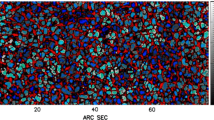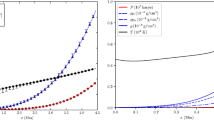Abstract
We compare horizontal velocities, vertical magnetic fields, and the evolution of trees of fragmenting granules (TFG, also named families of granules) derived in the quiet Sun at disk center from observations at solar minimum and maximum of the Solar Optical Telescope (SOT on board Hinode) and results of a recent 3D numerical simulation of the magneto-convection. We used 24-hour sequences of a 2D field of view (FOV) with high spatial and temporal resolution recorded by the SOT Broad band Filter Imager (BFI) and Narrow band Filter Imager (NFI). TFG were evidenced by segmentation and labeling of continuum intensities. Horizontal velocities were obtained from local correlation tracking (LCT) of proper motions of granules. Stokes V provided a proxy of the line-of-sight magnetic field (BLOS). The MHD simulation (performed independently) produced granulation intensities, velocity, and magnetic field vectors. We discovered that TFG also form in the simulation and show that it is able to reproduce the main properties of solar TFG: lifetime and size, associated horizontal motions, corks, and diffusive index are close to observations. The largest (but not numerous) families are related in both cases to the strongest flows and could play a major role in supergranule and magnetic network formation. We found that observations do not reveal any significant variation in TFG between solar minimum and maximum.












Similar content being viewed by others
References
Asensio Ramos, A., Requerey, I., Vitas, N.: 2017, Astron. Astrophys. 604, 11. DOI .
Asplund, M., Nordlund, Å., Trampedach, R., Allende Prieto, C., Stein, R.F.: 2000, Astron. Astrophys. 359, 743.
Carlsson, M., Stein, R.F., Nordlund, Å., Scharmer, G.B.: 2004, Astrophys. J. 610, 137. DOI .
Danilovic, S., Gandorfer, A., Lagg, A., Schüssler, M., Solanki, S., Vögler, A., Katsukawa, Y., Tsuneta, S.: 2008, Astron. Astrophys. 484, L17. DOI .
De Pontieu, B., Carlsson, M., Stein, R., Rouppe van der Voort, L., Löfdahl, M., van Noort, M., Nordlund, Å., Scharmer, G.: 2006, Astrophys. J. 646, 1404. DOI .
Dominguez Cerdeña, I., Sanchez Almeida, J., Kneer, F.: 2006, Astrophys. J. 646, 1421. DOI .
Fisher, G., Welsch, B.: 2008, ASP Conf. Ser. 383, 373.
Georgobiani, D., Zhao, J., Kosovichev, A., Benson, D., Stein, R., Nordlund, Å.: 2007, Astrophys. J. 657, 1157. DOI .
Giannattasio, F., Berrilli, F., Biferak, L., Del Moro, D., Sbragaglia, M., Bellot Rubio, L., Gošić, M., Orozco Suàrez, D.: 2014a, Astron. Astrophys. 569, 121. DOI .
Giannattasio, F., Strangalini, M., Berrilli, F., Del Moro, D., Bellot Rubio, L.: 2014b, Astrophys. J. 788, 137. DOI .
Gošic̀, M., Bellot Rubio, L., Orozco Suàrez, D., Katsukawa, Y., del Toro Iniesta, J.C.: 2014, Astrophys. J. 797, 49. DOI .
Ichimoto, K., Tsuneta, S., Suematsu, Y., Shimizu, T., Otsubo, M., Kato, Y., et al.: 2005, In: Mather, J.C. (ed.) Optical, Infrared, and Millimeter Space Telescopes, Proc. SPIE 5487, 1142.
Langangen, O., Carlsson, M., Rouppe van der Voort, L., Stein, R.: 2007, Astrophys. J. 655, 615. DOI .
Louis, R., Ravindra, B., Georgoulis, M., Küker, M.: 2015, Solar Phys. 290, 1135. DOI .
November, L.J., Simon, G.W.: 1988, Astrophys. J. 333, 427. DOI .
Orozco Suárez, D., Bellot Rubio, L., Del Toro Iniesta, J.C.: 2007, Astrophys. J. 662, L31. DOI .
Ossendrijver, M.: 2003, Astron. Astrophys. Rev. 11, 287. DOI .
Rieutord, M., Roudier, T., Ludwig, H., Nordlund, A., Stein, R.: 2001, Astron. Astrophys. 377, 14. DOI .
Rieutord, M., Roudier, T., Roques, S., Ducottet, C.: 2007, Astron. Astrophys. 471, 687. DOI .
Rosenthal, C.S., Christensen-Dalsgaard, J., Nordlund, Å., Stein, R.F., Trampedach, R.: 1999, Astron. Astrophys. 351, 689.
Roudier, T., Malherbe, J.M., Mirouh, G.M.: 2017, Astron. Astrophys. 598, 99. DOI .
Roudier, T., Rieutord, M., Malherbe, J.-M., Vigneau, J.: 1999, Astron. Astrophys. 349, 301.
Roudier, T., Lignières, F., Rieutord, M., Brandt, P.N., Malherbe, J.M.: 2003, Astron. Astrophys. 409, 299. DOI .
Roudier, T., Rieutord Malherbe, J.M., Renon, N., Berger, T., Frank, Z., Prat, V., Gizon, L., Svanda, M.: 2012, Astron. Astrophys. 540, 88.
Roudier, T., Malherbe, J.M., Rieutord, M., Frank, Z.: 2016, Astron. Astrophys. 590, 121. DOI .
Sheeley, N.R.: 2005, Living Rev. Solar Phys. 2, 5. DOI .
Stein, R.: 2012, Living Rev. Solar Phys. 9, 4. DOI .
Stein, R., Nordlund, Å.: 1998, Astrophys. J. 499, 914. DOI .
Stein, R., Nordlund, Å.: 2001, Astrophys. J. 546, 585. DOI .
Stein, R., Lagerfjård, A., Nordlund, Å., Georgobiani, D., Benson, D., Schaffenberger, W.: 2009, ASP Conf. Ser. 415, 63.
Suematsu, Y., Tsuneta, S., Ichimoto, K., Shimizu, T., Otsubo, M., Katsukawa, Y., et al.: 2008, Solar Phys. 249, 197. DOI .
Title, A., Tarbell, T., Topka, K., Ferguson, S., Shine, R.: 1989, Astrophys. J. 336, 475. DOI .
Verma, M., Steffen, M., Denker, C.: 2013, Astron. Astrophys. 555, 136. DOI .
Wedemeyer-Böhm, S., Rouppe van der Voort, L.: 2009, Astron. Astrophys. 503, 225. DOI .
Welsch, B., DeRosa, M., Fisher, G., Georgoulis, M., Kusano, K., Longcope, D., Ravindra, B., Schuck, P.: 2007, Astron. Astrophys. 670, 1434. DOI .
Zhao, J., Georgobiani, D., Kosovichev, A., Benson, D., Stein, R., Nordlund, Å.: 2007, Astrophys. J. 659, 848. DOI .
Acknowledgements
We are indebted to the Hinode team for the possibility to use their data. Hinode is a Japanese mission developed and launched by ISAS/JAXA, collaborating with NAOJ as a domestic partner, and NASA and STFC (UK) as international partners. Scientific operation of the Hinode mission is conducted by the Hinode science team organized at ISAS/JAXA. This team mainly consists of scientists from institutes in the partner countries. Support for the post-launch operation is provided by JAXA and NAOJ (Japan), STFC (UK), NASA, ESA, and NSC (Norway).
The authors wish to acknowledge the anonymous referee for helpful comments and suggestions to improve the manuscript.
Computing resources for the simulations were provided by the NASA High-End Computing Program through the NASA Advanced Supercomputing Division at the Ames Research Center.
This work was also supported by the Centre National de la Recherche Scientifique, France. We acknowledge access to the HPC resources of CALMIP under the allocation 2011-P1115.
Author information
Authors and Affiliations
Corresponding author
Electronic Supplementary Material
Below are the links to the electronic supplementary material.
Appendix
Appendix
The Electronic Supplemental Material movies are available in MP4 format.
-
Movie 1: horizontal velocities (\(\sqrt{v_{x}^{2}+v_{y}^{2}}\)) of Hinode/BFI from LCT of the blue continuum, 29 – 31 August 2007, sequence duration 48 hours, FOV \(65'' \times 75''\). Velocities in gray levels (LCT windows of 30 minutes/\(3.5''\)). The LOS magnetic field (Stokes V as a proxy of BLOS from Hinode/NFI blue wing of Fei 630.2 nm, pixel size \(0.16''\), five-minute-averaged) is shown in blue/orange for north/south polarities.
-
Movie 2: horizontal plasma velocities averaged through 30-minute/\(3.5''\) filters (LCT windows for comparison with movie 1) of the numerical simulation, sequence duration 26 hours, FOV \(131'' \times 131''\). Velocities in gray levels. The vertical component of the magnetic field (pixel size \(0.13''\), five-minute-averaged) is superimposed in blue/orange for north/south polarities.
-
Movie 3: Families of granules (TFG in various colors) derived from the Hinode/BFI blue continuum at 450.4 nm, 29 – 31 August 2007, sequence duration 48 hours, FOV \(90'' \times 105''\), pixel size \(0.11''\), together with horizontal velocities from LCT technique (30-minute/\(3.5''\) windows, gray levels).
-
Movie 4: Families of granules (TFG in various colors) provided by the numerical simulation, sequence duration 25 hours, FOV \(131'' \times 131''\), pixel size \(0.13''\), together with horizontal plasma velocities (gray levels, 30-minute and \(3.5''\) filtered through LCT windows for comparison with movie 3).
-
Movie 5: cork density (initially uniformly distributed over the FOV) represented by disks (size proportional to corks number, 10, 30, 100, 300, 1000, 3000, and 10000 or more). The corks are driven by horizontal LCT velocities (30-minute/\(3.5''\) windows) from the Hinode/BFI blue continuum at 450.4 nm, 29 – 31 August 2007, sequence duration 48 hours, FOV \(90'' \times 105''\). BLOS (Hinode/NFI blue wing of Fei 630.2 nm) is superimposed in blue/red for north/south polarities. In the background, Heii 30.4 nm intensities from Hinode/EIS are displayed in green.
-
Movie 6: cork density of the simulation represented by disks (size proportional to the number of corks). The corks are driven by horizontal plasma velocities, sequence duration 26 hours, FOV \(131'' \times 131''\). The vertical magnetic field is superimposed in blue/orange for north/south polarities. The time step is ten minutes and the averaging window \(3.5''\) (to allow comparison with movie 5).
Rights and permissions
About this article
Cite this article
Malherbe, JM., Roudier, T., Stein, R. et al. Dynamics of Trees of Fragmenting Granules in the Quiet Sun: Hinode/SOT Observations Compared to Numerical Simulation. Sol Phys 293, 4 (2018). https://doi.org/10.1007/s11207-017-1225-x
Received:
Accepted:
Published:
DOI: https://doi.org/10.1007/s11207-017-1225-x




